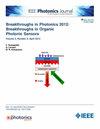Advancing OAM-Based FSO Systems: Tackling Pointing Errors for Next-Generation Space and Terrestrial Links
IF 2.4
4区 工程技术
Q3 ENGINEERING, ELECTRICAL & ELECTRONIC
引用次数: 0
Abstract
Orbital Angular Momentum (OAM)-based Free-Space Optical (FSO) communication systems offer immense potential for high-capacity, secure links, but their performance is highly sensitive to pointing errors. This paper provides a comprehensive analysis of OAM systems under pointing inaccuracies for both short-range terrestrial links and long-range inter-satellite communications. For short links, we demonstrate the trade-offs between increasing modulation order and the number of OAM modes, highlighting the potential of low-complexity two-stage detectors to mitigate computational overhead while maintaining robust performance. For inter-satellite links, where severe pointing errors dominate, we propose an innovative asymmetric mode design and optimal beam waist adjustment to enhance robustness against angular misalignments. Simulation results reveal critical insights into the interplay between pointing error intensity, mode selection, and system performance, offering practical guidelines for OAM system design in diverse scenarios. This work bridges the gap between theoretical modeling and real-world implementation, paving the way for reliable OAM-based communication in next-generation terrestrial and space networks.推进基于oam的FSO系统:解决下一代空间和地面链路的指向错误
基于轨道角动量(OAM)的自由空间光学(FSO)通信系统为高容量、安全链路提供了巨大的潜力,但其性能对指向误差高度敏感。本文综合分析了短距离地面链路和远距离卫星间通信中指向误差下的OAM系统。对于短链路,我们演示了增加调制顺序和OAM模式数量之间的权衡,强调了低复杂性两级检测器在保持稳健性能的同时减少计算开销的潜力。对于严重指向误差占主导地位的卫星间链路,我们提出了一种创新的非对称模式设计和最佳波束腰调整,以增强对角度失调的鲁棒性。仿真结果揭示了指向误差强度、模式选择和系统性能之间相互作用的关键见解,为不同场景下的OAM系统设计提供了实用指南。这项工作弥合了理论建模和现实世界实现之间的差距,为下一代地面和空间网络中基于oam的可靠通信铺平了道路。
本文章由计算机程序翻译,如有差异,请以英文原文为准。
求助全文
约1分钟内获得全文
求助全文
来源期刊

IEEE Photonics Journal
ENGINEERING, ELECTRICAL & ELECTRONIC-OPTICS
CiteScore
4.50
自引率
8.30%
发文量
489
审稿时长
1.4 months
期刊介绍:
Breakthroughs in the generation of light and in its control and utilization have given rise to the field of Photonics, a rapidly expanding area of science and technology with major technological and economic impact. Photonics integrates quantum electronics and optics to accelerate progress in the generation of novel photon sources and in their utilization in emerging applications at the micro and nano scales spanning from the far-infrared/THz to the x-ray region of the electromagnetic spectrum. IEEE Photonics Journal is an online-only journal dedicated to the rapid disclosure of top-quality peer-reviewed research at the forefront of all areas of photonics. Contributions addressing issues ranging from fundamental understanding to emerging technologies and applications are within the scope of the Journal. The Journal includes topics in: Photon sources from far infrared to X-rays, Photonics materials and engineered photonic structures, Integrated optics and optoelectronic, Ultrafast, attosecond, high field and short wavelength photonics, Biophotonics, including DNA photonics, Nanophotonics, Magnetophotonics, Fundamentals of light propagation and interaction; nonlinear effects, Optical data storage, Fiber optics and optical communications devices, systems, and technologies, Micro Opto Electro Mechanical Systems (MOEMS), Microwave photonics, Optical Sensors.
 求助内容:
求助内容: 应助结果提醒方式:
应助结果提醒方式:


